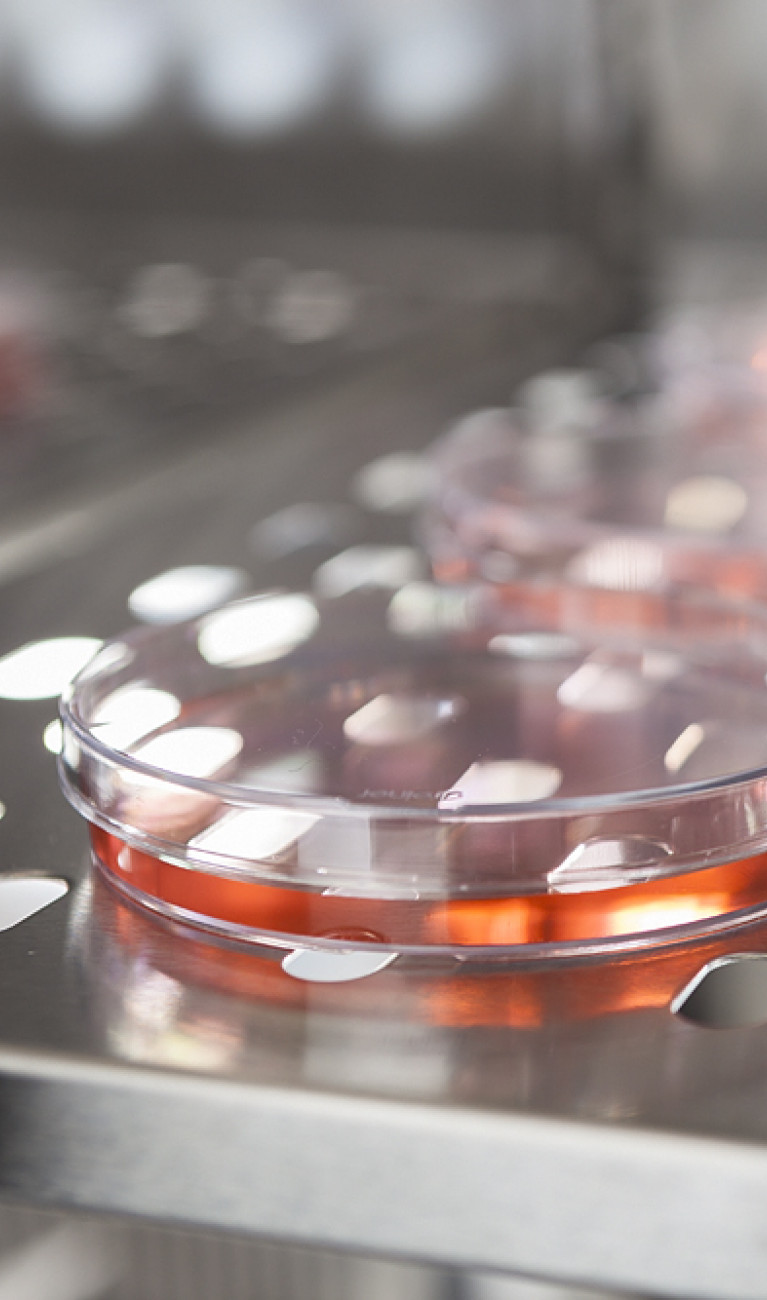
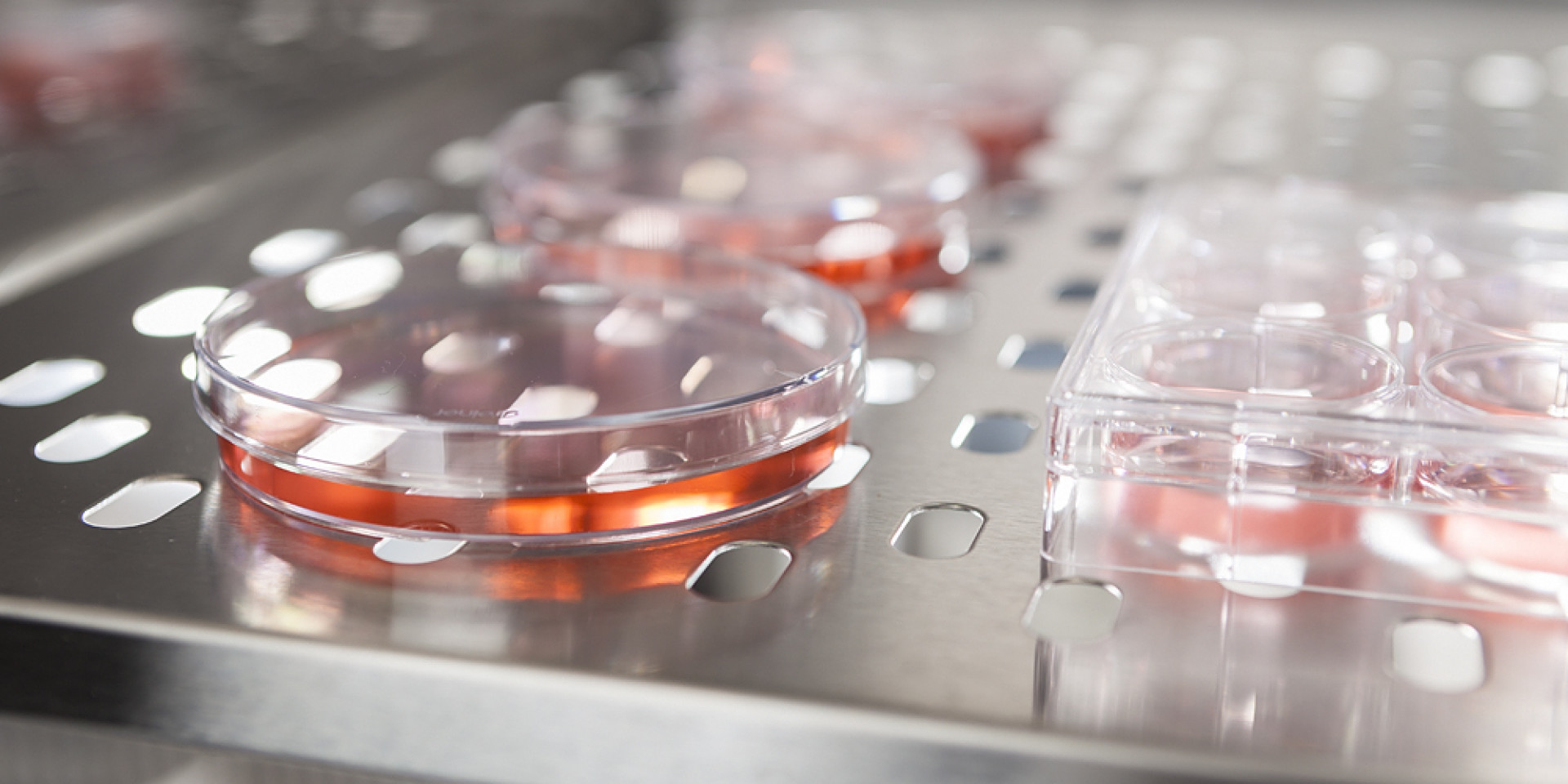
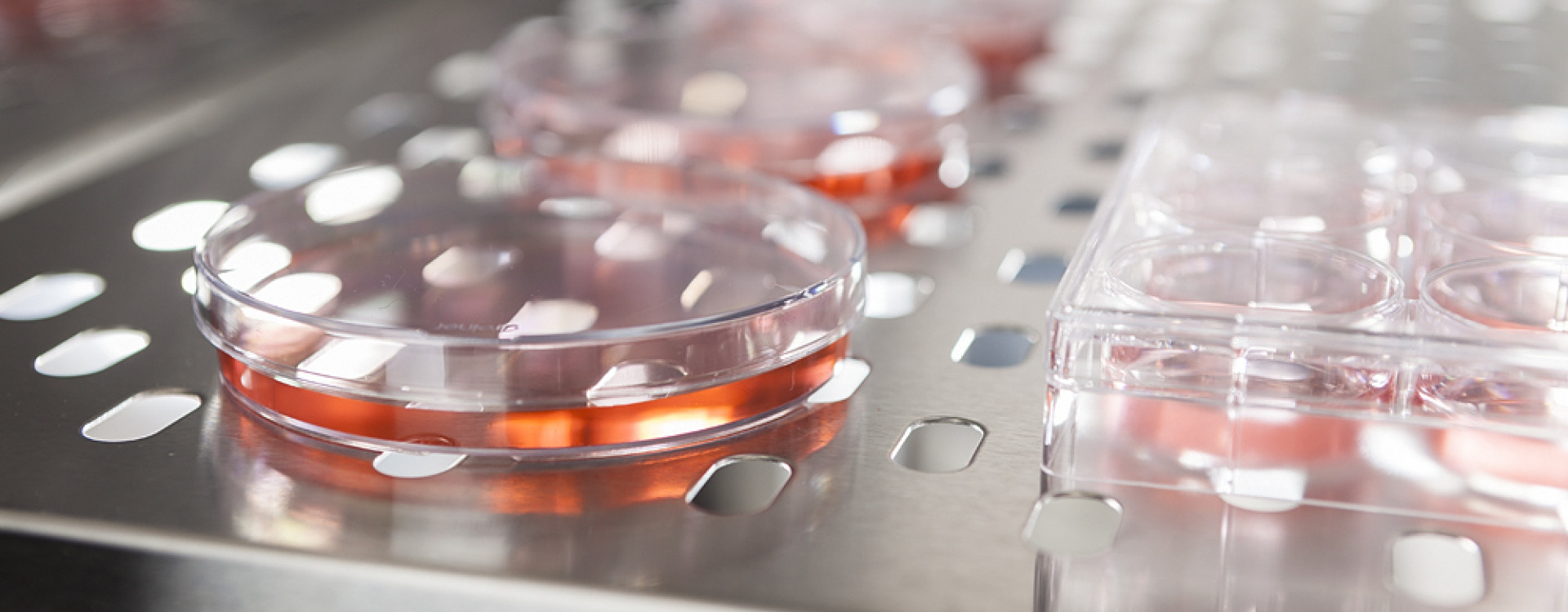



Mit der Gründung des Instituts für Angewandte Biotechnologie (IAB) wurden die Voraussetzungen für die Verankerung der biotechnologischen Forschung und Entwicklung an der Hochschule Biberach geschaffen. Das IAB befindet sich am Hochschulstandort Aspach im Gebäude PBT und ergänzt die Studiengänge „Pharmazeutische Biotechnologie" und „Industrielle Biotechnologie" mit einem entsprechend ausgerichteten Forschungsprogramm.
Die Kernkompetenz des Instituts ist der Herstellungsprozess für Biopharmazeutika sowie für Produkte der Industriellen (Weißen) Biotechnologie. In den verschiedenen Laboren des Instituts für Angewandte Biotechnologie wird der komplette biotechnologische Herstellungsprozess abgebildet - von der Etablierung von Zelllinien und Mikroorganismen bis hin zur Fermentation, Proteinaufreinigung und Proteinanalytik. Die hochmoderne Ausstattung der Labore der Studiengänge und des IABs ermöglicht die Bearbeitung aktueller und progressiver Projekte in diesen Bereichen.
Das Institut für Angewandte Biotechnologie (IAB) der Hochschule Biberach fokussiert den biotechnologischen Herstellungsprozess. Die Zusammenarbeit der einzelnen Labore ermöglicht dabei die Forschung und Entwicklung einzelner Teilaspekte, aber auch die Weiterentwicklung und Durchführung des gesamten Prozesses von der Klonierung eines Gens bis hin zur Aufreinigung und Analytik des Produkts.
Bei den Forschungsprojekten des IAB handelt es sich um sowohl öffentlich geförderte Projekte als auch Auftragsforschungsprojekte. Sie werden in Zusammenarbeit mit der Industrie sowie nationalen und internationalen Hochschulen realisiert. Darüber hinaus bietet das IAB Forschungsprojekte für Studien-, Bachelor- & Masterarbeiten an.
Bioprocess Engineering (Prof. Dr. Sybille Ebert)
Polymerabbau durch marine Mikroorganismen
Erschließung neuer kostengünstiger Substratquellen
Reinigung von Enzymen
Process Engineering (Prof. Dr. Heike Frühwirth)
Metabolic uptake of trace elements by extremophile microalgae
Purge to Value – Development of value added products with low environmental impact from the purge water of microalgae cultivation, Funded under: Southeast Asia – Europe Joint Funding Scheme for Research
Skalierungslabor – Im Rahmen des Hochschulverbundes InnoSüd, gefördert vom Bundesministerium für Bildung und Forschung (BMBF) und den Ländern Baden Württemberg und Bayern
Prokaryotic Production Systems / Glycosylation (Prof. Dr. Sabine Gaisser)
Expression einer funktionellen rekombinanten Glykosyltransferase in Escherichia coli
Applied Microbiology (Prof. Dr. Hartmut Grammel)
CASCOO – Bacterial Pathways and Enzymes for Conversion of CO2
EnzCaps – Selection of Organic Solvent-tolerant Bacterial Strains and Enzymes
NXP-SynPath – Development of a novel N-controlled Expression System for Large-Scale Production of Recombinant Proteins
Current research projects are running under the roof of the funding initiative "Biotechnologie 2020+" initiated by the German Federal Ministry for Education and Research (BMBF)
Computational Biology, Metabolic Engineering, Bioprocess Simulation (Prof. Dr. Oliver Hädicke)
System-Bioprozesstechnik
Stofffluss- und Pathwayanalysen
Metabolic Engineering / Rationales Stammdesign
Modellierung und Analyse biotechnologischer Prozesse
Process Engineering, MicroRNAs, Protein Aggregation (Prof. Dr. Friedemann Hesse)
Identifizierung prozessrelevanter miRNAs in Produktionszelllinien
Protein Downstream Processing (Prof. Dr. Hans Kiefer)
Regulatory Affairs and Quality / GMP (Prof. Dr. Chrystelle Mavoungou)
Entwicklung und Testung einer intranasalen Applikation von ZNS-wirksamen Antikörperformaten
Cell Line Development / Cell Engineering / MicroRNAs (Prof. Dr. Kerstin Otte)
Bioprocess Engineering (Prof. Dr. Annette Schafmeister)
Drug Delivery, Antibody Engineering, Assay Development (Prof. Dr. Katharina Zimmermann)
ALIVE
Intranasal drug delivery with domain antibodies
N2B-patch
FcRn in N2B
3D for 3R
Intranasal delivery of proteins
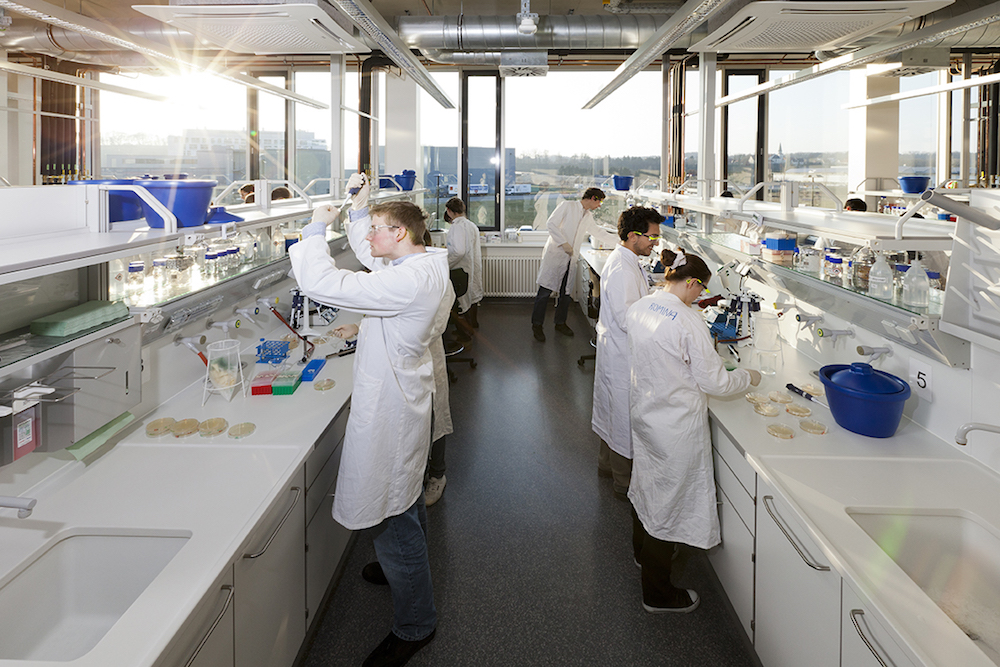
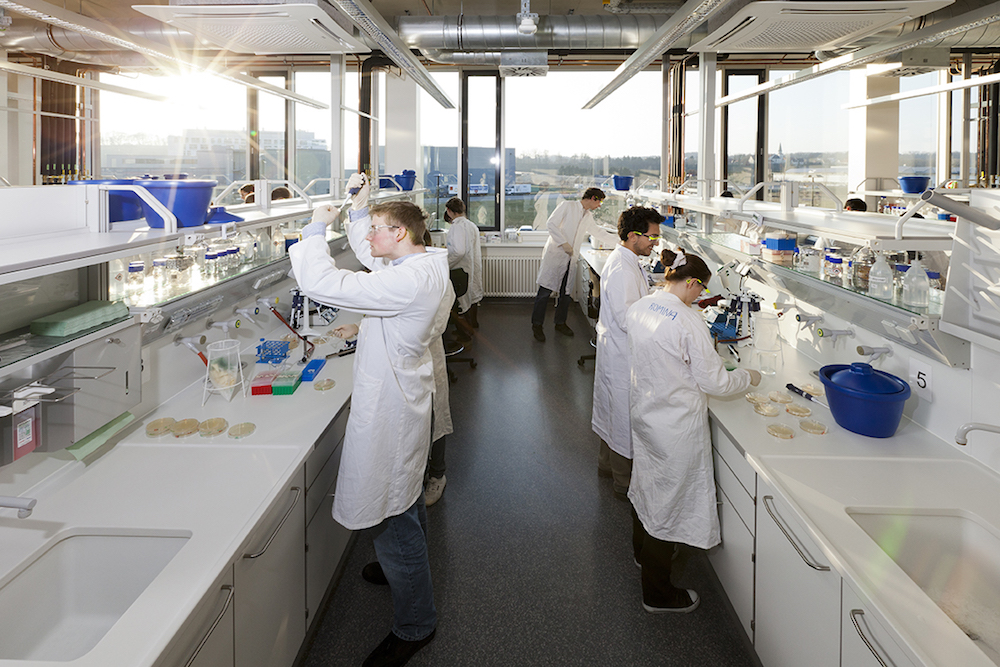
Die Laboraustattung des IAB ermöglicht externe und interne Forschungs-, Entwicklungs- und Auftragsarbeiten. Die Arbeitsgruppen orientieren sich thematisch und technisch am roten Faden des Herstellungsprozesses für Biopharmazeutika und arbeiten fächerübergreifend.
Das IAB hat Kompetenzen in zahlreichen Fachbereichen, u.a. der Molekularbiologie, Gentechnik, Mikrobiologie, Fermentation und Zellkulturtechnik.
1. Herdoíza PE, Crauwels P, Bergner T, Wiederspohn N, Förstner S, Rinas R, Ruf A, Kleemann M, Handrick R, Tuckermann J, Otte K, Walther P, Riedel CU (2019) miR-124-5p regulates phagocytosis of human macrophages by targeting the actin cytoskeleton via the ARP2/3 complex, Front. Immunol., doi: 10.3389/fimmu.2019.02210
2. Handl A, López-Lorente ÁI, Handrick R, Mizaikoff B, Hesse F (2019) Infrared attenuated total reflection and 2D fluorescence spectroscopy for the discrimination of differently aggregated monoclonal antibodies, Analyst., doi: 10.1039/c9an00424f
3. Zeh N, Schneider H, Mathias S, Raab N, Kleemann M, Schmidt-Hertel S, Weis B, Wissing S, Strempel N, Handrick R, Otte K (2019) Human CAP cells represent a novel source for functional, miRNA-loaded exosome production, PLoS One., doi: 10.1371/journal.pone.0221679
4. Gauttam R, Seibold GM, Mueller P, Weil T, Weiß T, Handrick R, Eikmanns BJ (2019) A simple dual-inducible CRISPR interference system for multiple gene targeting in Corynebacterium glutamicum, Plasmid., doi: 10.1016/j.plasmid.2019.04.001
5. Ladel S, Schlossbauer P, Flamm J, Luksch H, Mizaikoff B, Schindowski K (2019) Improved In Vitro Model for Intranasal Mucosal Drug Delivery: Primary Olfactory and Respiratory Epithelial Cells Compared with the Permanent Nasal Cell Line RPMI 2650, Pharmaceutics., doi: 10.3390/pharmaceutics11080367
6. Witt A, Pozzi R, Diesch S, Hädicke O, Grammel H (2019) New light on ancient enzymes - in vitro CO2 Fixation by Pyruvate Synthase of Desulfovibrio africanus and Sulfolobus acidocaldarius, FEBS J., doi: 10.1111/febs.14981
7. Raab N, Mathias S, Alt K, Handrick R, Fischer S, Schmieder V, Jadhav V, Borth N, Otte K (2019) CRISPR/Cas9-Mediated Knockout of MicroRNA-744 Improves Antibody Titer of CHO Production Cell Lines, Biotechnol J., doi: 10.1002/biot.201800477
8. Blech M, Hörer S, Kuhn AB, Kube S, Göddeke H, Kiefer H, Zang Y, Alber Y, Kast SM, Westermann M, Tully MD, Schäfer LV, Garidel P (2019) Structure of a Therapeutic Full-Length Anti-NPRA IgG4 Antibody: Dissecting Conformational Diversity, Biophys J., doi: 10.1016/j.bpj.2019.03.036
9. Solemani Zadeh A, Grässer A, Dinter H, Hermes M, Schindowski K (2019) Efficient Construction and Effective Screening of Synthetic Domain Antibody Libraries, Methods Protoc., doi: 10.3390/mps2010017
10. Kleemann M, Schneider H, Unger K, Bereuther J, Fischer S, Sander P, Marion Schneider E, Fischer-Posovszky P, Riedel CU, Handrick R, Otte K (2019) Induction of apoptosis in ovarian cancer cells by miR-493-3p directly targeting AKT2, STK38L, HMGA2, ETS1 and E2F5, Cell Mol Life Sci., doi: 10.1007/s00018-018-2958-x
1. Mueller P, Gauttam R, Raab N, Handrick R, Wahl C, Leptihn S, Zorn M, Kussmaul M, Scheffold M, Eikmanns B, Elling L, Gaisser S (2018) High level in vivo mucin-type glycosylation in Escherichia coli, Microb Cell Fact., doi: 10.1186/s12934-018-1013-9
2. Weis BL, Guth N, Fischer S, Wissing S, Fradin S, Holzmann KH, Handrick R, Otte K (2018) Stable miRNA overexpression in human CAP cells: Engineering alternative production systems for advanced manufacturing of biologics using miR-136 and miR-3074, Biotechnol Bioeng., doi: 10.1002/bit.26715
3. Gänger S, Schindowski K (2018) Tailoring Formulations for Intranasal Nose-to-Brain Delivery: A Review on Architecture, Physico-Chemical Characteristics and Mucociliary Clearance of the Nasal Olfactory Mucosa, Pharmaceutics., doi: 10.3390/pharmaceutics10030116
4. Ladel S, Flamm J, Zadeh AS, Filzwieser D, Walter JC, Schlossbauer P, Kinscherf R, Lischka K, Luksch H, Schindowski K (2018) Allogenic Fc Domain-Facilitated Uptake of IgG in Nasal Lamina Propria: Friend or Foe for Intranasal CNS Delivery?, Pharmaceutics, doi: 10.3390/pharmaceutics10030107
5. Kleemann M, Schneider H, Unger K, Sander P, Schneider EM, Fischer-Posovszky P, Handrick R, Otte K (2018) MiR-744-5p inducing cell death by directly targeting HNRNPC and NFIX in ovarian cancer cells, Sci Rep., doi: 10.1038/s41598-018-27438-6.
6. Flum M, Kleemann M, Schneider H, Weis B, Fischer S, Handrick R, Otte K (2018) miR-217-5p induces apoptosis by directly targeting PRKCI, BAG3, ITGAV and MAPK1 in colorectal cancer cells, J Cell Commun Signal., doi: 10.1007/s12079-017-0410-x
7. Paul AJ, Handrick R, Ebert S, Hesse F (2018) Identification of process conditions influencing protein aggregation in Chinese hamster ovary cell culture, Biotechnol Bioeng., doi: 10.1002/bit.26534
8. Mathias S, Fischer S, Handrick R, Fieder J, Schulz P, Bradl H, Gorr I, Gamer M, Otte K (2018) Visualisation of intracellular production bottlenecks in suspension-adapted CHO cells producing complex biopharmaceuticals using fluorescence microscopy, J Biotechnol., doi: 10.1016/j.jbiotec.2018.02.009
9. Flamm J, Boscher M, Maigler F, Akana C, Lindemann J, Kleiner S, Sommer F, Schindowski K (2018) Standardized refined intranasal administration for region-specific intranasal drug deposition in mice established with 3D rapid prototypes under 3R criteria, Berl Münch Tierärztl Wochenschc
1. Röhm M, Carle S, Maigler F, Flamm J, Kramer V, Mavoungou C, Schmid O, Schindowski K (2017) A comprehensive screening platform for aerosolizable protein formulations for intranasal and pulmonary drug delivery, Int J Pharm, doi: 10.1016/j.ijpharm.2017.09.027
2. Oyetayo OO, Méndez-Lucio O, Bender A, Kiefer H (2017) Towards understanding polyol additive effects on the pH shift-induced aggregation of a monoclonal antibody using high throughput screening and quantitative structure-activity modelling, Int J Pharm., doi: 10.1016/j.ijpharm.2017.07.059
3. Paul AJ, Bickel F, Röhm M, Hospach L, Halder B, Rettich N, Handrick R, Herold EM, Kiefer H, Hesse F (2017) High-throughput analysis of sub-visible mAb aggregate particles using automated fluorescence microscopy imaging , Anal Bioanal Chem., doi: 10.1007/s00216-017-0362-2
4. Schwab K, Hesse F (2017) Estimating Extrinsic Dyes for Fluorometric Online Monitoring of Antibody Aggregation in CHO Fed-Batch Cultivations, Bioengineering (Basel), doi: 10.3390/bioengineering4030065
5. Schoellhorn M, Fischer S, Wagner A, Handrick R, Otte K (2017) miR-143 targets MAPK7 in CHO cells and induces a hyperproductive phenotype to enhance production of difficult-to-express proteins, Biotechnol Prog., doi: 10.1002/btpr.2475
6. Schindowski K (2017) Regulation of Neurotrophic Factors during Pathogenic Tau-Aggregation: A Detailed Protocol for Double-Labeling mRNA by In Situ Hybridization and Protein Epitopes by Immunohistochemistry, Methods Mol Biol., doi: 10.1007/978-1-4939-6598-4_27
1. Kleemann M, Bereuther J, Fischer S, Marquart K, Hänle S, Unger K, Jendrossek V, Riedel C, Handrick R, Otte K (2016) Investigation on tissue specific effects of pro-apoptotic miR-147b as a potential biomarker in ovarian cancer prognosis. Oncotarget doi: 10.18632/oncotarget.13095
2. Emmerling VV, Fischer S, Kleemann M, Handrick R, Kochanek S, Otte K (2016) miR-483 is a self-regulating microRNA and activates its own expression via USF1 in human cells. Int J Biochem Cell Biol. doi: 10.1016/j.biocel.2016.09.022.
3. Stiefel F, Fischer S, Sczyrba A, Otte K, Hesse F (2016) miRNA profiling of high, low and non-producing CHO cells during biphasic fed-batch cultivation reveals process relevant targets for host cell engineering. J Biotechnol. doi: 10.1016/j.jbiotec.2016.03.028
4. Schrade A, Kyrönlahti A, Akinrinade O, Pihlajoki M, Fischer S, Rodriguez VM, Otte K, Velagapudi V, Toppari J, Wilson DB, Heikinheimo M (2016) GATA4 regulates blood-testis barrier function and lactate metabolism in mouse Sertoli cells. Endocrinology.
5. Fischer S, Handrick R, Otte K (2016) Pushing the limits of protein production. Drug target 3, 20-23
6. Engelhardt L, Röhm M, Mavoungou C, Schindowski K, Schafmeister A, Simon U (2016). First Steps To Develop And Validate A CFPD Model In Order To Support The Design Of Nose-To-Brain Delivered Biopharmaceuticals. Pharm Res, 1-14.
7. Schwab K, Lauber J, Hesse F (2016) Fluorometric In Situ Monitoring of an Escherichia coli Cell Factory with Cytosolic Expression of Human Glycosyltransferase GalNAcT2: Prospects and Limitations, Bioengineering (Basel), doi: 10.3390/bioengineering3040032
8. Schwab K, Amann T, Schmid J, Handrick R, Hesse F (2016) Exploring the capabilities of fluorometric online monitoring on chinese hamster ovary cell cultivations producing a monoclonal antibody, Biotechnol Prog., doi: 10.1002/btpr.2326
9. Oyetayo OO, Kiefer H (2016) Experimental Model System to Study pH Shift-Induced Aggregation of Monoclonal Antibodies Under Controlled Conditions, Pharm Res., doi: 10.1007/s11095-016-1878-4
10. Emmerling VV, Fischer S, Stiefel F, Holzmann K, Handrick R, Hesse F, Hörer M, Kochanek S, Otte K (2016) Temperature-sensitive miR-483 is a conserved regulator of recombinant protein and viral vector production in mammalian cells, Biotechnol Bioeng., doi: 10.1002/bit.25853
11. Guo S, Kiefer H, Zhou D, Guan YH, Wang S, Wang H, Lu Y, Zhuang Y (2016) A scale-down cross-flow filtration technology for biopharmaceuticals and the associated theory, J Biotechnol., doi: 10.1016/j.jbiotec.2016.01.002
12. Röhm M, Handl A, König M, Mavoungou C, Handrick R, Schindowski K (2016) Data of rational process optimization for the production of a full IgG and its Fab fragment from hybridoma cells, Data Brief, doi: 10.1016/j.dib.2016.05.067
1. Fischer S, Handrick R, Otte K (2015) The art of CHO cell engineering: A comprehensive retrospect and future perspectives. Biotechnol Adv, doi:10.1016/j.biotechadv.2015.10.015.
2. Emmerling VV, Fischer S, Stiefel F, Holzmann K, Handrick R, Hesse F, Hörer M, Kochanek S, Otte K (2015) Temperature-sensitive miR-483 is a conserved regulator of recombinant protein and viral vector production in mammalian cells. Biotech Bioeng 10, DOI:10.1002/bit.25853
3. Fischer S, Mathias S, Schaz S, Emmerling VV, Buck T, Kleemann M, Hackl M, Grillari J, Aschrafi A, Handrick R, Otte K (2015) Enhanced protein production by microRNA-30 family in CHO cells is mediated by the modulation of the ubiquitin pathway. J Biotechnol 232, 32-43
4. Osswald A, Sun Z, Grimm V, Ampem G, Riegel K, Westendorf AM, Sommergruber W, Otte K, Dürre P, Riedel CU (2015) Three-dimensional tumor spheroids for in vitro analysis of bacteria as gene delivery vectors in tumor therapy. Microb Cell Fact 14 (1), 199.
5. Stiefel F, Fischer S, Hackl M, Handrik R, Hesse F, Borth N, Otte K and Grillari J (2015) Noncoding RNAs, post-transcriptional RNA operons and Chinese hamster ovary cells. Pharmaceutical Bioprocessing 4, 1-21, doi: 10.4155/pbp.14.65
6. Fischer S and Otte K (2015) Tiny but Mighty: miRNAs to Boost Biopharmaceutical Production. G.I.T. Laboratory Journal 5-6, 22-23
7. Fischer S, Handrick R, Aschrafi A, Otte K (2015) Unveiling the principle of redundancy in cellular pathway regulation by microRNAs. RNA Biology 12(3), 1-10
8. Fischer S, Paul AJ, Wagner A, Mathias S, Geiss M, Schandock F, Domnowski M, Zimmermann J, Handrick R, Hesse F, Otte K (2015) miR-2861 as novel HDAC5 inhibitor in CHO cells enhances productivity while maintaining product quality. Biotechnol Bioeng. doi: 10.1002/bit.25626.
9. Paul AJ, Schwab K, Prokoph N, Haas E, Handrick R, Hesse F (2015): Fluorescence dye-based detection of mAb aggregates in CHO culture supernatants. Anal Bioanal Chem, 407:4849–4856, DOI 10.1007/s00216-015-8672-8.
10. Stiefel F, Paul AJ, Jacopo T, Sgueglia A, Stutzle M, Herold EM, Hesse F (2015): The influence of bisphenol A on mammalian cell cultivation. Appl Microbiol Biotechnol, DOI 10.1007/s00253-015-6956-8.
11. Stützle M, Flamm J, Carle S, Schindowski K (2015). Nose-to-Brain delivery of insulin for Alzheimer's disease. ADMET and DMPK 3 (3), 190-202
12. Interview mit Prof. Dr. Katharina Zimmermann und Prof. Dr. Chrystelle Mavoungou. „Ein Vorteil der Hochschulforschung ist, dass man zu jedem Thema forschen kann.", horizonte 46 / 2015
13. Flamm J, Carle S, Stützle M, Schindowski K. How biopharmaceutical drug substances use the nose as a pathway to the brain: Behind the doorman's back, Lab & More International edition. 4 / 2015
14. Flamm J, Carle S, Stützle M, Schindowski K. Wie Biopharmazeutische Wirkstoffe Über Die Nase Ins Gehirn Gelangen Können: Am Türsteher vorbei gemogelt, Labor & More 3 / 2015
1. Fischer S, Handrick R, Otte K (2015) The art of CHO cell engineering: A comprehensive retrospect and future perspectives. Biotechnol Adv, doi:10.1016/j.biotechadv.2015.10.015.
2. Emmerling VV, Fischer S, Stiefel F, Holzmann K, Handrick R, Hesse F, Hörer M, Kochanek S, Otte K (2015) Temperature-sensitive miR-483 is a conserved regulator of recombinant protein and viral vector production in mammalian cells. Biotech Bioeng 10, DOI:10.1002/bit.25853
3. Fischer S, Mathias S, Schaz S, Emmerling VV, Buck T, Kleemann M, Hackl M, Grillari J, Aschrafi A, Handrick R, Otte K (2015) Enhanced protein production by microRNA-30 family in CHO cells is mediated by the modulation of the ubiquitin pathway. J Biotechnol 232, 32-43
4. Osswald A, Sun Z, Grimm V, Ampem G, Riegel K, Westendorf AM, Sommergruber W, Otte K, Dürre P, Riedel CU (2015) Three-dimensional tumor spheroids for in vitro analysis of bacteria as gene delivery vectors in tumor therapy. Microb Cell Fact 14 (1), 199.
5. Stiefel F, Fischer S, Hackl M, Handrik R, Hesse F, Borth N, Otte K and Grillari J (2015) Noncoding RNAs, post-transcriptional RNA operons and Chinese hamster ovary cells. Pharmaceutical Bioprocessing 4, 1-21, doi: 10.4155/pbp.14.65
6. Fischer S and Otte K (2015) Tiny but Mighty: miRNAs to Boost Biopharmaceutical Production. G.I.T. Laboratory Journal 5-6, 22-23
7. Fischer S, Handrick R, Aschrafi A, Otte K (2015) Unveiling the principle of redundancy in cellular pathway regulation by microRNAs. RNA Biology 12(3), 1-10
8. Fischer S, Paul AJ, Wagner A, Mathias S, Geiss M, Schandock F, Domnowski M, Zimmermann J, Handrick R, Hesse F, Otte K (2015) miR-2861 as novel HDAC5 inhibitor in CHO cells enhances productivity while maintaining product quality. Biotechnol Bioeng. doi: 10.1002/bit.25626.
9. Paul AJ, Schwab K, Prokoph N, Haas E, Handrick R, Hesse F (2015): Fluorescence dye-based detection of mAb aggregates in CHO culture supernatants. Anal Bioanal Chem, 407:4849–4856, DOI 10.1007/s00216-015-8672-8.
10. Stiefel F, Paul AJ, Jacopo T, Sgueglia A, Stutzle M, Herold EM, Hesse F (2015): The influence of bisphenol A on mammalian cell cultivation. Appl Microbiol Biotechnol, DOI 10.1007/s00253-015-6956-8.
11. Stützle M, Flamm J, Carle S, Schindowski K (2015). Nose-to-Brain delivery of insulin for Alzheimer's disease. ADMET and DMPK 3 (3), 190-202
12. Interview mit Prof. Dr. Katharina Zimmermann und Prof. Dr. Chrystelle Mavoungou. „Ein Vorteil der Hochschulforschung ist, dass man zu jedem Thema forschen kann.", horizonte 46 / 2015
13. Flamm J, Carle S, Stützle M, Schindowski K. How biopharmaceutical drug substances use the nose as a pathway to the brain: Behind the doorman's back, Lab & More International edition. 4 / 2015
14. Flamm J, Carle S, Stützle M, Schindowski K. Wie Biopharmazeutische Wirkstoffe Über Die Nase Ins Gehirn Gelangen Können: Am Türsteher vorbei gemogelt, Labor & More 3 / 2015
1. Carius L, Rumschinski P, Faulwasser T, Flockerzi D, Grammel H, and R. Findeisen. 2013. Model-based derivation, analysis and control of unstable microaerobic steady-states - considering Rhodospirillum rubrum as an example. Biotechnol Bioeng. Biotechnol Bioeng. 111(4):734-47
2. Carius L, Carius AB, McIntosh M, and H. Grammel. 2013. Quorum sensing influences growth and photosynthetic membrane production in high-cell-density cultivations of Rhodospirillum rubrum. BMC Microbiol. 2013 Aug 8;13(1):189.
3. Carius L, Hädicke O, and H. Grammel. 2013. Stepwise reduction of the culture redox potential allows the analysis of microaerobic metabolism and photosynthetic membrane synthesis in Rhodospirillum rubrum. Biotechnol Bioeng. 110(2):573-85.
4. Albert Paul, Albrecht Weber, Friedemann Hesse
Proteinaggregate analysieren: SEC-MALS bei Biomolekülen
GIT Laborfachzeitschrift, Seite 376 ff, Ausgabe: Juni 2013, GIT Verlag
5. Fischer S, Wagner A, Kos A, Aschrafi A, Handrick R, Hannemann J, Otte K.
Breaking limitations of complex culture media: Functional non-viral miRNA delivery into pharmaceutical production cell lines.
J Biotechnol. 2013 Aug 29. doi:pii: S0168-1656(13)00374-X. 10.1016/j.jbiotec.2013.08.027.
6. MORETH, Jens; MAVOUNGOU, Chrystelle; SCHINDOWSKI, Katharina. Passive anti-amyloid immunotherapy in Alzheimer's disease: What are the most promising targets?. Immunity & Ageing, 2013, 10. Jg., Nr. 1, S. 18.
7. MORETH, Jens; MAVOUNGOU, Chrystelle; SCHINDOWSKI, Katharina Zimmermann. Is Abeta a sufficient Biomarker for monitoring anti-Abeta clinical studies? A critical review. Frontiers in Aging Neuroscience, 5. Jg., S. 25.
8. Chrystelle Mavoungou and Katharina Schindowski Zimmermann
Immunotherapy with Anti-Aβ Monoclonal Antibodies in Alzheimer's Disease: A Critical Review on the Molecules in the Pipelines with Regulatory Considerations
in: Frontiers in Clinical Drug Research – Alzheimer Disorders
Chapter DOI: 10.2174/9781608057221113010003
Page: 3-85 (83)
Editor(s): Atta-ur-Rahman
DOI: 10.2174/97816080572211130101
eISBN: 978-1-60805-722-1 ISBN: 978-1-60805-723-8 ISSN :2214-5168
9. C. Mavoungou, K. Schindowski
Was hilft gegen das Vergessen?, Antikörper in der Therapie der Alzheimer Krankheit
GIT Labor-Fachzeitschrift 11/2013, Seite 717
10. Martina Stützle, Alina Moll, René Handrick, Katharina Schindowski. Optimized fermentation conditions for improved antibody yield in hybridoma cells BMC Proceedings 2013, 7(Suppl 6):P74 doi:10.1186/1753-6561-7-S6-P74
11. Fischer S, Wagner A, Kos A, Aschrafi A, Handrick R, Hannemann J, Otte K (2013) Breaking limitations of complex culture media: functional non-viral miRNA delivery into pharmaceutical production cell lines. Journal of Biotechnology, 168(4), 589-600
12. Otte K (2013) Fachkräfte für die Biotechnologiebranche. Ausbildungssituation am Standort Deutschland. Pharmind, 11, 1738 - 1742.
13. Mavoungou C, Schindowski K. Was hilft gegen das Vergessen?, Antikörper in der Therapie der Alzheimer Krankheit. GIT Labor-Fachzeitschrift S.717, 11/2013
1. Macchi F, Eisenkolb M, Kiefer H, Otzen DE.: The effect of osmolytes on protein fibrillation, Int J Mol Sci. 2012;13(3):3801-19. doi: 10.3390/ijms13033801. Epub 2012 Mar 21.
2. Park SH, Das BB, Casagrande F, Tian Y, Nothnagel HJ, Chu M, Kiefer H, Maier K, De Angelis AA, Marassi FM, Opella SJ.: Structure of the chemokine receptor CXCR1 in phospholipid bilayers, Nature. 2012 Nov 29;491(7426):779-83. doi: 10.1038/nature11580. Epub 2012 Oct 21.
3. Boubeva, R, Reichert, C., Handrick, R, Müller, C., Hannemann, J. and Borchard, G.
New Expression Method and Characterization of Recombinant Human Granulocyte Colony Stimulating Factor in a Stable Protein Formulation. CHIMIA 2012, Vol. 66, (5): 281-285
4. Carius L, Hädicke O, Grammel H, Stepwise reduction of the culture redox potential allows the analysis of microaerobic metabolism and photosynthetic membrane synthesis in Rhodospirillum rubrum. Biotechnol Bioeng. 2012 Oct 5. doi: 10.1002/bit.24734.
5. Wang GS, Grammel H, Abou-Aisha K, Sägesser R, Ghosh R. High-level production of the industrial product lycopene by the photosynthetic bacterium Rhodospirillum rubrum. Appl Environ Microbiol. 2012 Oct;78(20):7205-15.
6. Rudolf C, Grammel H. Fructose metabolism of the purple non-sulfur bacterium Rhodospirillum rubrum: effect of carbon dioxide on growth, and production of bacteriochlorophyll and organic acids. Enzyme Microb Technol. 2012 Apr 5;50(4-5):238-46.
7. Franz A, Rehner R, Kienle A, Grammel H. Rapid selection of glucose-utilizing variants of the polyhydroxyalkanoate producer Ralstonia eutropha H16 by incubation with high substrate levels. Lett Appl Microbiol. 2012 Jan;54(1):45-51.
8. Carrondo MJ, Alves PM, Carinhas N, Glassey J, Hesse F, Merten OW, Micheletti M, Noll T, Oliveira R, Reichl U, Staby A, Teixeira AP, Weichert H, Mandenius CF. How can measurement, monitoring, modeling and control advance cell culture in industrial biotechnology? Biotechnol J. 2012 Dec;7(12):1522-9. doi: 10.1002/biot.201200226. Epub 2012 Sep 5.
9. Thaisuchat H, Baumann M, Pontiller J, Hesse F, Ernst W. Identification of a novel temperature sensitive promoter in CHO cells. BMC Biotechnol. 2011 May 12;11(1):51. doi: 10.1186/1472-6750-11-51.
10. Stiefel F, Wagner A, Hesse F. Vergleich Kultivierung von Säugerzellen in Polykarbonat- und PEGT-Schüttelkolben. Thermo Scientific, Have a Look!, Oktober/November/Dezember 2012, 20-21
1. Mavoungou, Chr. / Zimmermann, K.:Zielgerichtet: Qualität in der pharmazeutischen Herstellung-Validieren geht über Probieren, Labor&More 1/2011
(Deutsche Ausgabe).
2. Mavoungou, Chr. / Zimmermann, K.: Target oriented: Quality in pharmaceutical manufacturing - validation is more than only testing, Labor&More 1/2011
(English edition).
3. Mavoungou, Chr. / Zimmermann, K. : Dans un
but précis: La qualité Ia dans fabrication des produits pharmaceutiques - La validation passe par ces études approfondies, Labor&More 1/2011 (edition Française).
4. Zimmermann, K. / Mavoungou,Chr ./ Schafmeister, A. / Stülze, M.: Therapeutische Antikörper auf ihrem Weg ins Gehirn: Immer der Nase nach, Labor&More 5 / 2011.
5. Zimmermann, K. / Mavoungou, Chr. / Schafmeister, A. / Stülze, M.: Immer der Nase nach: Wie bekommt man biopharmazeutische Wirkstoffe ins Gehirn?; Horizonte Nr. 38 2011, S. 20 f.
6. Belarbi, K. / Burnouf, S. / Fernandez-Gomez, F.J. / Desmercières, J. / Troquier, L. / Brouillette, J. / Tsambou, L. / Grosjean, M.E. / Caillierez, R. / Demeyer, D. / Hamdane, M. / Schindowski Zimmermann, K. / Blum, D. / Buée, L.: Loss of Medial Septum Cholinergic Neurons in THY-Tau22 Mouse Model: What Links with tau Pathology?, Curr Alzheimer Res., 2011 Sep 1, 8(6): 633-8 (Thomson Reuters-Liste, siehe Anlage).
7. Park, S.H. / Casagrande, F. / Chu, M / Maier, K. /
Kiefer, H. / Opella, S.J.: Optimization of purification and refolding of the human chemokine receptor CXCR1 improves the stability of proteoliposomes for structure determination, Biochimica et Biophysica Acta - Biomembranes,2011 Oct 14, 1818 (3): 584-591 (Thomson Reuters-Liste, siehe Anlage).
8. Schindowski-Zimmermann, K. / von Bohlen und
Halbach, O. / Strelau, J. / Ridder, D.A. / Herrmann, O. / Schober, A. / Schwaninger, M. / Unsicker, K.: Regulation of GDF-15, a distant TGF-β superfamily member, in a mouse model of cerebral ischemia, Cell Tissue Res, 2011 Feb, 343 (2): 399-409 (Thomson Reuters-Liste, siehe Anlage).
9. Ranta, F. / Leveringhaus, J. / Theilig, D. / Schulz Raffelt, G. / Hennige, A.M. / Hildebrand, D.G. / Handrick, R. / Jendrossek, V. / Bosch, F. / Schulze-Osthoff, K. / Häring, H.-U. / Ullrich, S.: Protein Kinase
C Delta (PKCd) Affects Proliferation of Insulin-Secreting Cells by Promoting Nuclear Extrusion of the Cell Cycle
Inhibitor p21Cip1/WAF1, PLoS One, 2011, (12): e28828, Epub 2011 Dec 27 (Thomson Reuters-Liste, siehe Anlage).
10. Zang, Y. / Kammerer, B. / Eisenkolb, M. / Lohr,
K. / Kiefer, H. : Towards protein crystallization as a process step in downstream processing of therapeutic antibodies: screening and optimization at microbatch scale, PLoS One., 2011, 6 (9): e25282, Epub 2011 Sep 22 (Thomson)
1. Handrick, R., Ontikatze, T., Bauer, KD., Freier, F., Rübel, A., Dürig, J., Belka, C., Jendrossek, V.: Dihydroartemisinin induces apoptosis by a Bak-dependent intrinsic pathway. Mol Cancer Ther., 09/2010, 9(9):2497-510. Epub 2010 Jul 27 à aufgenommen in Thomson-Reuter-Liste (siehe Anlage)
2. Jörissen, H., Bektas, N., Dahl, E., Hartmann, A., ten Haaf, A., Di Fiore, S., Kiefer, H., Thess, A., Barth, S., Klockenbring, T.: Production and characterisation of monoclonal antibodies against RAI3 and its expression in human breast cancer. BMC Cancer 9:200 (2009) (Nachmeldung aus 2009, da es als einfache Publikation aufgeführt wurde) à aufgenommen in Thomson-Reuter-Liste (siehe Anlage)
3. Rudner, J., Ruiner, CE., Handrick, R., Eibl, HJ, Belka, C, Jendrossek, V., Radiat Oncol.: The Akt-inhibitor Erufosine induces apoptotic cell death in prostate cancer cells and increases the short term effects of ionizing radiation. 11/2010, 16;5(1):108. [Epub ahead of print] à aufgenommen in Thomson-Reuter-Liste (siehe Anlage)
4. Handrick, R., Kozakiewicz, F., Doederlein, T., Schad, M., Riechers, D., Otte, K. and Hannemann, J. : Optimization of monoclonal antibody production employing SENSOLUXR noninvasive sensor technology. Application Note Sartorius Stedim Biotech, 2010
5. Casagrande, F., Maier, K., Kiefer, H., Opella, S., Park, S.H.:
in Production of Membrane Proteins: "Expression and Purification of G-Protein Coupled Receptors for NMR", Structural Studies "Strategies for Expression and Isolation. (Robinson, A, Ed.) Wiley-VCH publishers, 2010 (Buchkapitel)
6. Schindowski-Zimmermann, K., von Bohlen und Halbach, O., Strelau, J., Herrmann, O., Ridder DA, Schober, A., Schwaninger, M., Unsicker, K.: Regulation of GDF-15, a novel TGF-beta superfamily member, in a mouse model of cerebral ischemia. Cell Tis Res. 2010 Dec 3. [Epub ahead of print] DOI: 10.1007/s00441-010-1090-5
Sie interessieren sich für die Forschungsarbeit und die Dienstleistungen des Institutes?
Nehmen Sie Kontakt mit der Institutsleitung auf!
